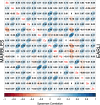Exposure to heavy metals in utero and autism spectrum disorder at age 3: a meta-analysis of two longitudinal cohorts of siblings of children with autism
- PMID: 38970053
- PMCID: PMC11225197
- DOI: 10.1186/s12940-024-01101-2
Exposure to heavy metals in utero and autism spectrum disorder at age 3: a meta-analysis of two longitudinal cohorts of siblings of children with autism
Abstract
Background: Autism spectrum disorder (ASD) is a prevalent and heterogeneous neurodevelopmental disorder. Risk is attributed to genetic and prenatal environmental factors, though the environmental agents are incompletely characterized.
Methods: In Early Autism Risk Longitudinal Investigation (EARLI) and Markers of Autism Risk in Babies Learning Early Signs (MARBLES), two pregnancy cohorts of siblings of children with ASD, urinary metals concentrations during two pregnancy time periods (< 28 weeks and ≥ 28 weeks of gestation) were measured using inductively coupled plasma mass spectrometry. At age three, clinicians assessed ASD with DSM-5 criteria. In an exposure-wide association framework, using multivariable log binomial regression, we examined each metal for association with ASD status, adjusting for gestational age at urine sampling, child sex, age at pregnancy, race/ethnicity and education. We meta-analyzed across the two cohorts.
Results: In EARLI (n = 170) 17% of children were diagnosed with ASD, and 44% were classified as having non-neurotypical development (Non-TD). In MARBLES (n = 231), 21% were diagnosed with ASD, and 14% classified as Non-TD. During the first and second trimester period (< 28 weeks), having cadmium concentration over the level of detection was associated with 1.69 (1.08, 2.64) times higher risk of ASD, and 1.29 (0.95, 1.75)times higher risk of Non-TD. A doubling of first and second trimester cesium concentration was marginally associated with 1.89 (0.94, 3.80) times higher risk of ASD, and a doubling of third trimester cesium with 1.69 (0.97, 2.95) times higher risk of ASD.
Conclusion: Exposure in utero to elevated levels of cadmium and cesium, as measured in urine collected during pregnancy, was associated with increased risk of developing ASD.
Keywords: Autism spectrum disorder; Cadmium; Epidemiology; ExWAS; Metals exposure; Pregnancy cohort.
© 2024. The Author(s).
Conflict of interest statement
The authors declare they have no competing interests.
Figures



Update of
-
Exposure to heavy metals in utero and autism spectrum disorder at age 3: A meta-analysis of two longitudinal cohorts of siblings of children with autism.medRxiv [Preprint]. 2023 Dec 5:2023.11.21.23298827. doi: 10.1101/2023.11.21.23298827. medRxiv. 2023. Update in: Environ Health. 2024 Jul 5;23(1):62. doi: 10.1186/s12940-024-01101-2. PMID: 38045240 Free PMC article. Updated. Preprint.
References
-
- American Psychiatric Association. APA Publishing information: American Psychiatric Association. Diagnostic and Statistical Manual of Mental Disorders : DSM-5. 5th ed. American Psychiatric Association Publishing; 2013.
-
- Maenner MJ, Warren Z, Williams AR, et al. Prevalence and characteristics of autism spectrum disorder among children aged 8 years - autism and developmental disabilities monitoring network, 11 sites, United States, 2020. MMWR Surveill Summ. 2023;72(2):1–14. doi: 10.15585/mmwr.ss7202a1. - DOI - PMC - PubMed
-
- Cakir J, Frye RE, Walker SJ. The lifetime social cost of autism: 1990–2029. Res Autism Spectr Disord. 2020;72(January):1–18. doi: 10.1016/j.rasd.2019.101502. - DOI

